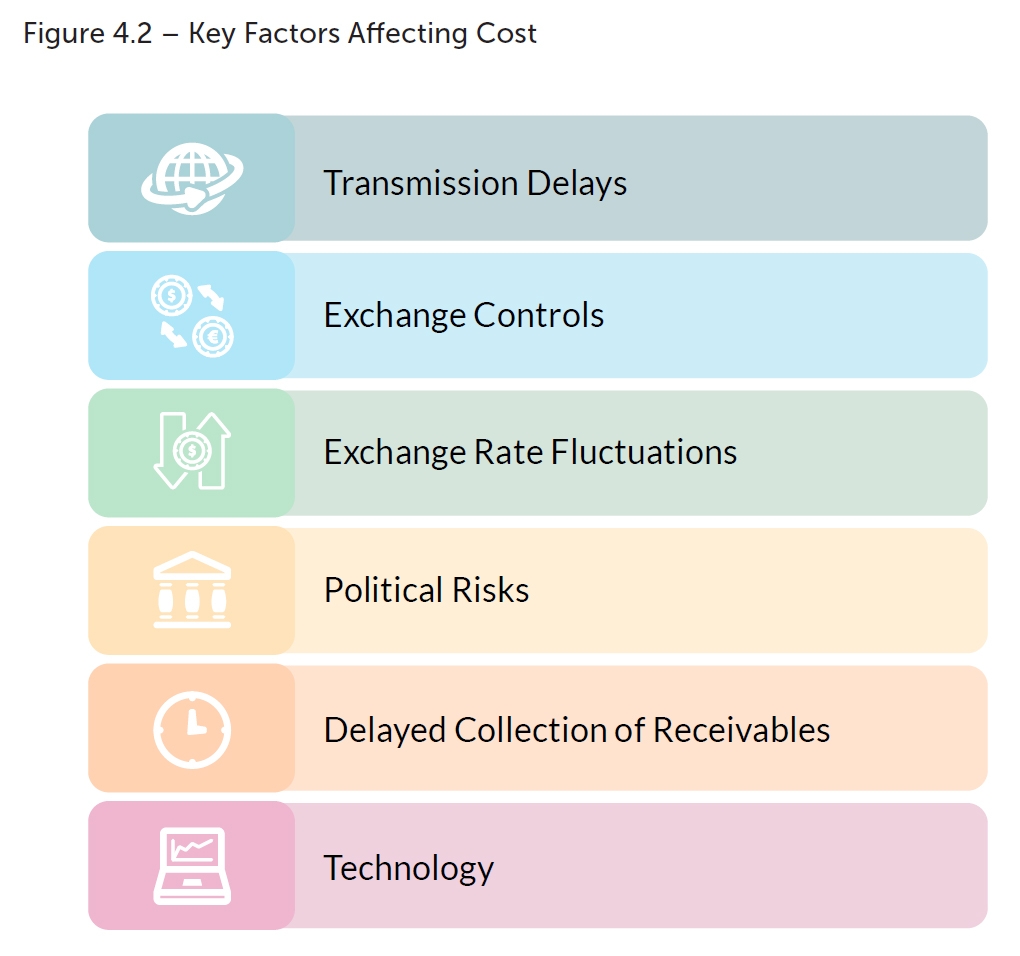
Making the leap from domestic sales to an operation that’s doing business internationally comes with a new range of considerations. Not least of these would be to calculate business costs in any new markets.
Any business exploring a new international market needs to taking into consideration new costs such as those associated with international shipping, currency exchange, and methods of payment, many of which are unique to international business and come with associated risks.
Organizations trading abroad must understand the different factors that can affect their business costs. These factors are shown in the following image and explained below.
1. Transmission delays
Transmission delays, an often-overlooked cost of doing business abroad, can affect cash flow significantly. International shipments and the resulting payments are complex enough—delays can slow the transmission of funds from the paying country to the receiving country by a few days to several weeks. The cash budget must consider the possibility of technical or bureaucratic delays along the payment chain.
The delays may be the result of improperly completed documentation or foreign administrative procedures. New exporters may be able to plan for the types of delays experienced in their domestic business, but they can be unpleasantly surprised when international business delays are far longer than they expect.
2. Exchange controls
Resulting from the host government’s attempt to conserve its hard currency reserves, exchange controls can prevent or restrict the payment of funds by the trading parties in a country. Often enforced by a cumbersome and lengthy system of foreign currency authorization, these regulations impose more problems for capital repatriation transactions than for payment of arm’s-length invoices.
At times, export controls can result in all payments being stopped. This can have a devastating effect on a company’s cash flow, and it should be insured against if the amounts involved are relatively large.
Want to learn more about all aspects of how to manage business costs and cash flows, ensure payment and stay profitable long-term? Get started with the FITTskills International Trade Finance online course!
3. Exchange rate fluctuations
Foreign exchange rate (FX) fluctuations can reduce the value of the proceeds from a sale or increase the value of the funds needed to pay for a transaction. Unless planned for and controlled through risk management techniques, such fluctuations can seriously undermine expected cash flows, or surprisingly increase profit, hence the need for the margin on the contract.
4. Political risks
Political risks can also severely affect a company’s cash flow. For instance, the revocation of an export or import permit frustrates performance under an international trade transaction. In the meantime, the exporter may have already covered the costs of arranging for the export sales, purchased supplies, fixed business costs, paid salaries or prepared the products for shipment. Such a situation will have an obvious negative impact on cash flow.
5. Delayed collection of receivables
The slower collection of international accounts receivable can strain a company’s cash position. To avoid this, care must be taken to select appropriate payment terms for each foreign buyer, and to factor likely delays into the cash budget. If the receivables involved are substantial, the exporter should use export credit insurance or export receivables discounting facilities to avoid excess risk.
6. Technology
Trade finance and logistics providers are investing significantly in the enhancement of technology and related reporting capabilities, working to turn the provision of timely information and high transactional visibility into a significant element of their value proposition to importers and exporters on a global basis. Technology—from processing systems to web-accessed software and sophisticated reporting systems—is enabling the delivery of trade finance solutions across the life of a transaction, and doing so at an ever-faster pace, to keep up with the evolving needs and increasing expectations of importers and exporters.
The latest developments in trade finance include significant forays by leading global banks into areas that traditionally have not been the purview of trade bankers but are increasingly so today. Logistics, customs brokerage, supply chain finance and management are all information areas that are of critical value to importers and exporters.






disqus comments